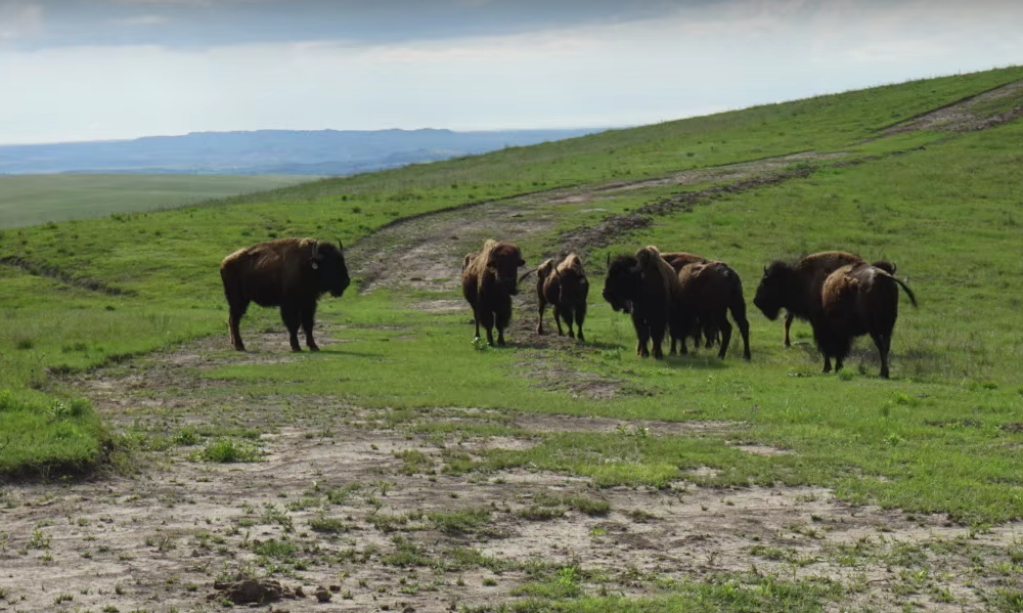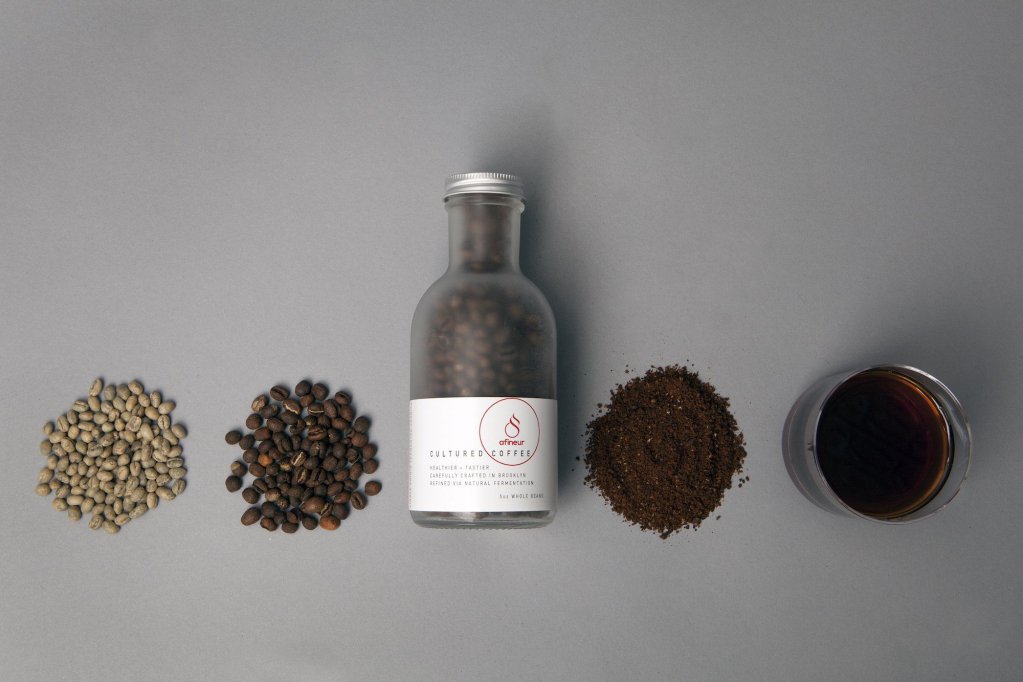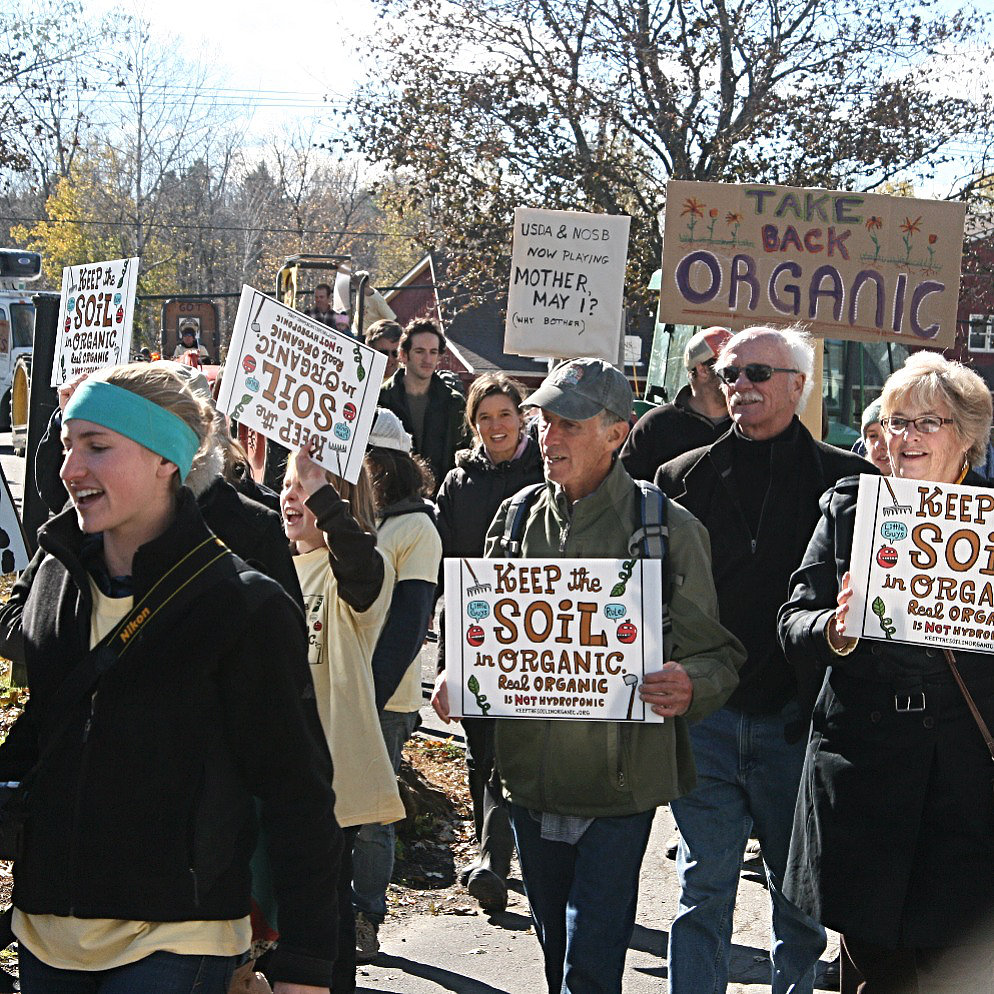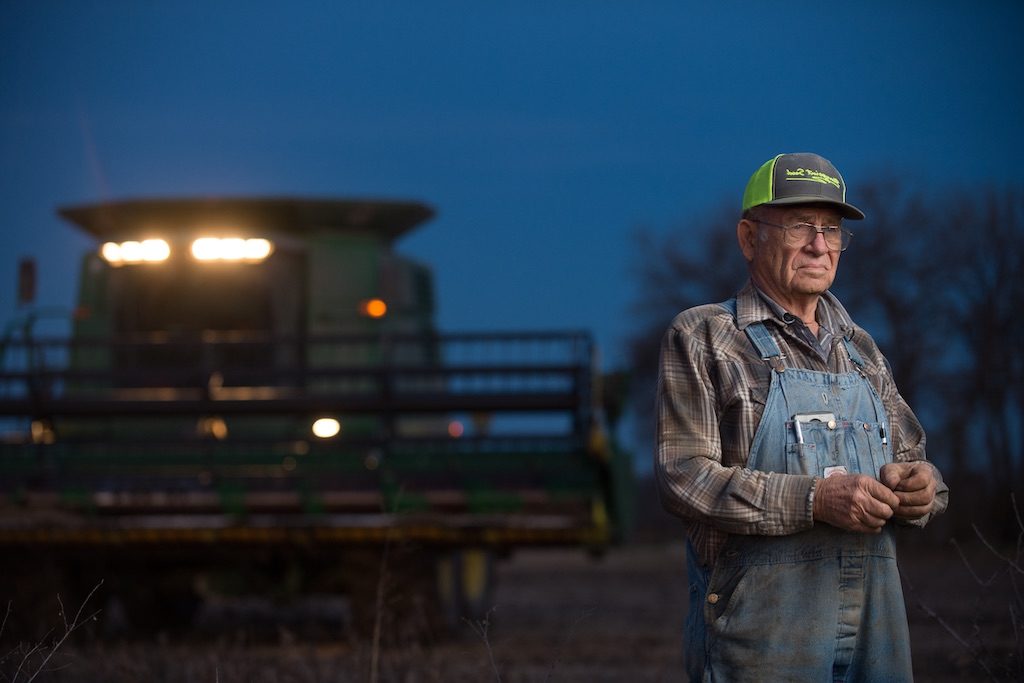
Luke Townsend
It’s a late weekday afternoon when I get the call inviting me to come ride. I quickly throw on jeans and boots and several layers to shield against the November chill. It’s a short drive, but when I pull off the road, the combine is already going full tilt, three to five miles per hour. Soon enough the John Deere is bearing down on me, towering 14 feet tall and nearly twice as wide, spitting out a cloud of dust that trails in its wake like smoke. I throw my hands up in greeting, and alarm.
“I wasn’t going to hit ya,” John Hertlein calls down with a chuckle, throwing open the door to the cab. I climb up the green ladder to join him, and he pulls around to begin harvesting another row of soybeans.
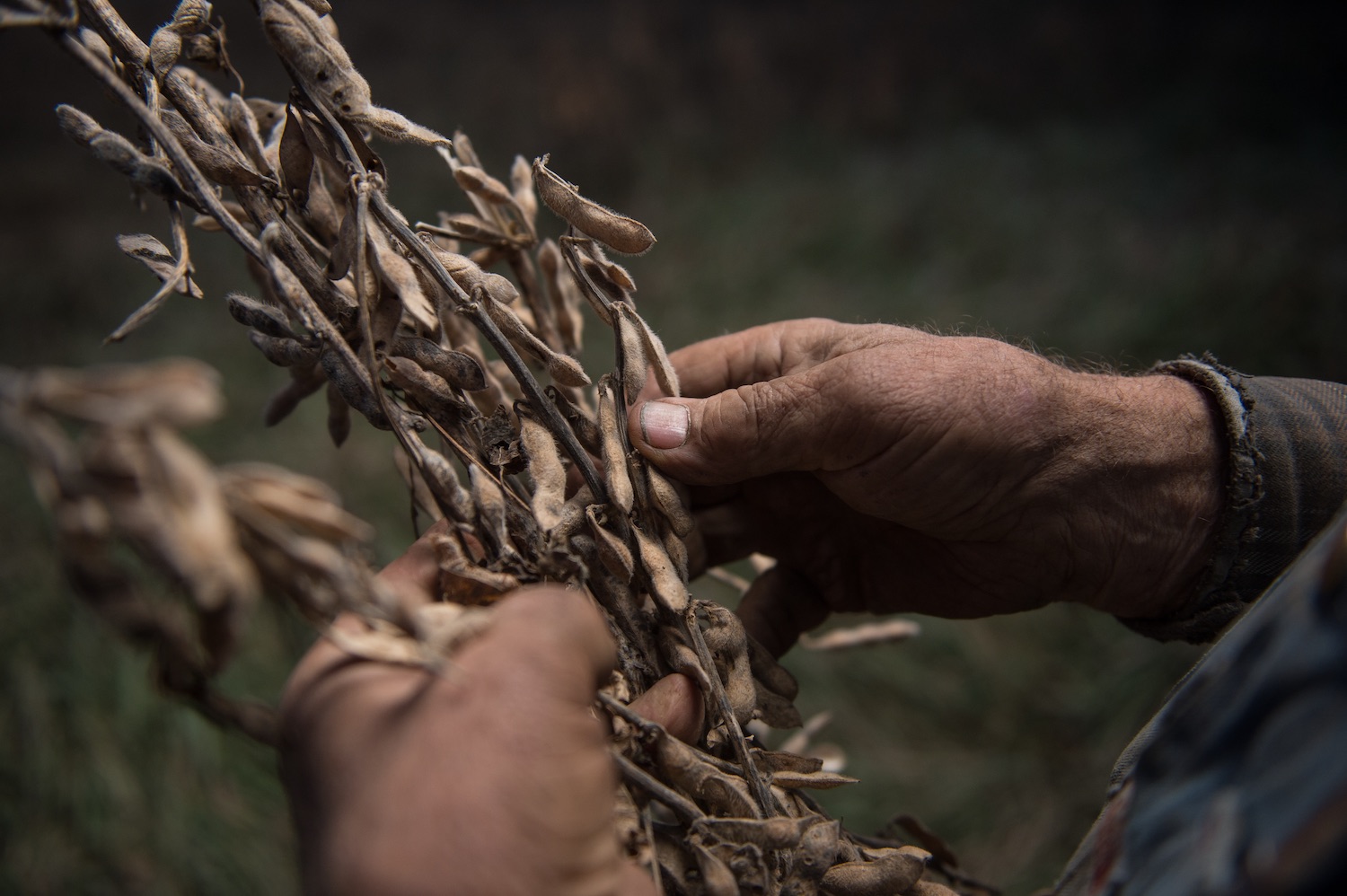
Like most soybean farmers, John Hertlein is unsure about whether his harvest will turn a profit in 2018 due to Trump’s trade war
Luke Townsend
Hertlein lives just a few miles away from the house where I grew up in Emporia, Kansas. Born in 1938 at the “home place” in Morris County, 50 miles northwest of Emporia, he’s worked the land much of his life, whether raising cattle or growing grains or a little bit of both. “Once you get farming in your blood,” he says, “it never leaves.”
Hertlein works with his 48-year-old son Jim, and together they farm about 580 acres, including six acres my parents own. (Like many farmers in the United States, most of the acreage the Hertleins work is owned by someone else, and they share their profits from those fields with the landlord.)
More than 80 percent of their fields are planted with soybeans. The Chinese-American trade war has hit the soybean market particularly hard, and the recent agreement between President Trump and Chinese President Xi Jinping oscillates between tentative and tenuous. In the face of so much uncertainty, a looming question for the Hertleins, and for more than 300,000 other American soybean farmers, is whether or not their efforts will turn a profit this year.
Soybean prices have recently fallen to decade lows. While in past years farmers have tried to sell their beans for $10 or more per bushel—in 2017, Kansas farmers received an average of $8.95 per bushel—this year, prices at local grain elevators have hovered well below $8 per bushel. The $0.82 per bushel that the federal government has said it will pay soybean farmers as part of the tariff relief package USDA announced in July will make up for less than half of that difference. Even if the federal government doubles those payments this month as farmers hope, soybean farmers may only break even, at best.
An equally pressing question is whether farmers’ efforts will turn a profit next year. The USDA has forecasted soybean acreage in the U.S. will drop by 6.6 million acres in 2019 as farmers opt to grow other crops, but the Hertleins expect to plant about the same number of acres of soybeans next year. Even with the current uncertainty, soybeans are still the most profitable crop to grow in the area—with more than 90,000 acres, they are easily the top crop in Lyon County. Local farmers are hoping that the trade conflict gets resolved quickly, and are optimistically planting according to what has worked in the past. However, if the trade war between China and the U.S. continues, they might lose out in 2019, too.
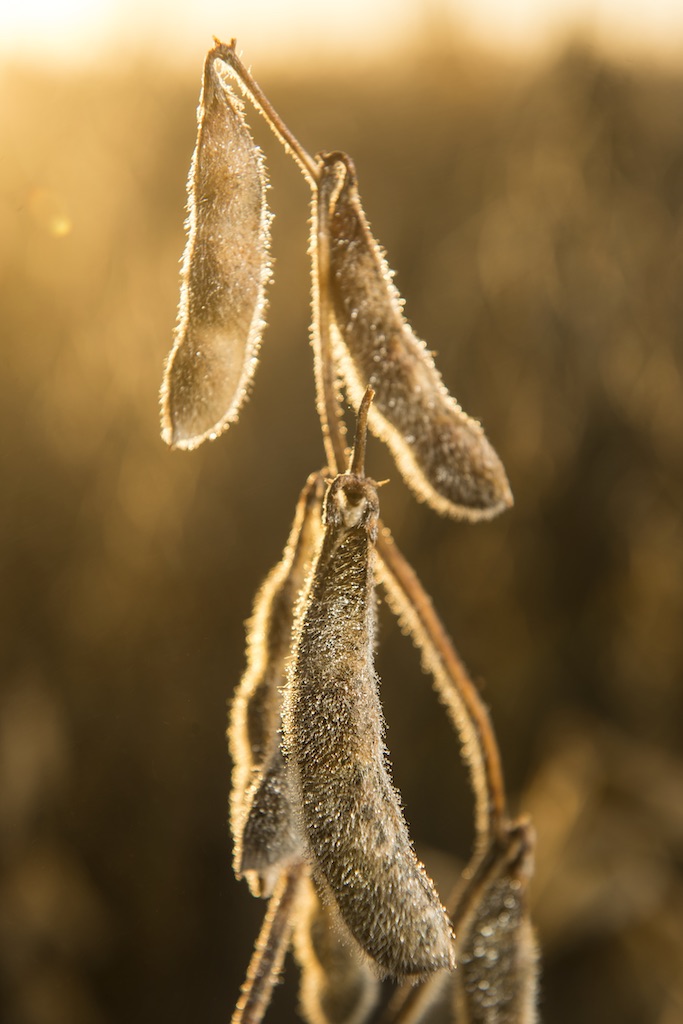
Luke Townsend
This year, imports of U.S. soybeans have plummeted 94 percent
Soybeans grow in the field next to my house, and in half a dozen other fields on the drive into town. They were a fixture of the landscape as I was growing up, but I never stopped to wonder why that might be, or whether that might ever change. At least, I didn’t until the crop began making headlines earlier this year. Only then did I start to ask: Where do all those soybeans go? And, what happens now, if China won’t buy them?
U.S. farmers supplied approximately 33 million tons of soybeans to China in 2017. This year, imports of U.S. soybeans have plummeted 94 percent. Farmers across the country are already storing as much of their harvest as possible, hoping for a resolution to the trade war and better prices, but a glut of stored soybeans might lower the price of beans next year, too. The impact on my parents is negligible, as the income from those six acres is a tiny fraction of what they live on. But what about our neighbors, the Hertleins? What about the 15,000 other soybean farms in Kansas? Are they all just as vulnerable to the whims of the market, or is there another way? I traveled home to find out.
Quiet dominance
The soybean is a humble-looking plant: the stalks approximately knee-high—sometimes shorter, sometimes taller—the hairy pods shriveled and brown by harvest time. As a child, I wondered why there wasn’t something more picturesque, more Kansan, growing in the field next to our house, like wheat, or corn, or even sunflowers, which give our state its nickname. I didn’t know that soybeans are just about the most American crop there is—surpassing corn as the most-planted field crop in the U.S. earlier this year.
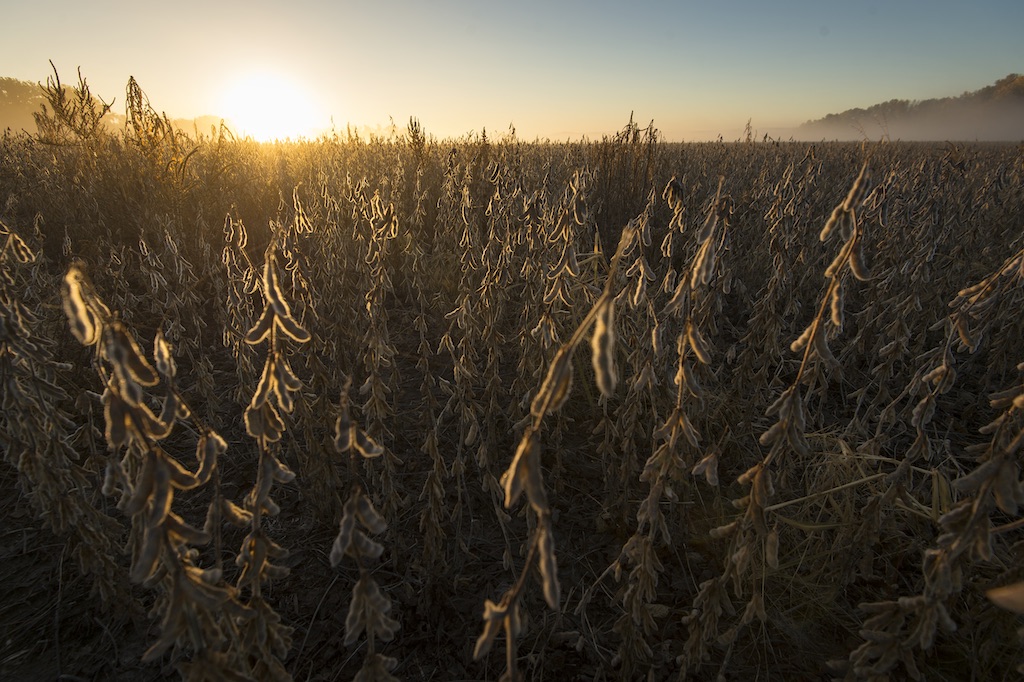
Hertlein praises the versatility of soybeans: “They can make plastic, make ink—matter fact, I think you can make just about anything out of beans.”
Luke Townsend
Soybeans are an unlikely agricultural staple in this country. At the beginning of the 20th century, there were perhaps 50,000 acres grown for hay, but not for the bean; this year, the Department of Agriculture estimates 89 million acres were planted. “The rise of the soybean was one of the most remarkable success stories of the twentieth-century,” historian Matthew Roth writes in his book, Magic Bean: The Rise of Soy In America.
Although soy products like tofu have been consumed for tens of decades in this country by certain populations like Asian-Americans, Seventh-day Adventists, and health- and environmentally-conscious eaters, most soy products are consumed indirectly or invisibly—as cooking oil, the ubiquitous emulsifier soy lecithin, or as soy-fed beef, pork, poultry, and even factory-farmed fish.
The explosive dominance of soy over a century went unnoticed by most Americans, except for those growing it.
“There’s a lot of things made out of soybeans,” Hertlein tells me. “They can make plastic, make ink—matter fact, I think you can make just about anything out of beans.”
It all begins in the field. The draper head, fitted onto the front of the combine, has rotating bars covered in spikes that draw the beanstalks in toward the machine, where a saw-toothed cutting edge nips the stalks off at their base. An auger feeds the stalks and pods into the body of the combine, where the beans are knocked out and fed into a grain tank. The leftover bits of pods and stalks, or chaff, are blown out the back.
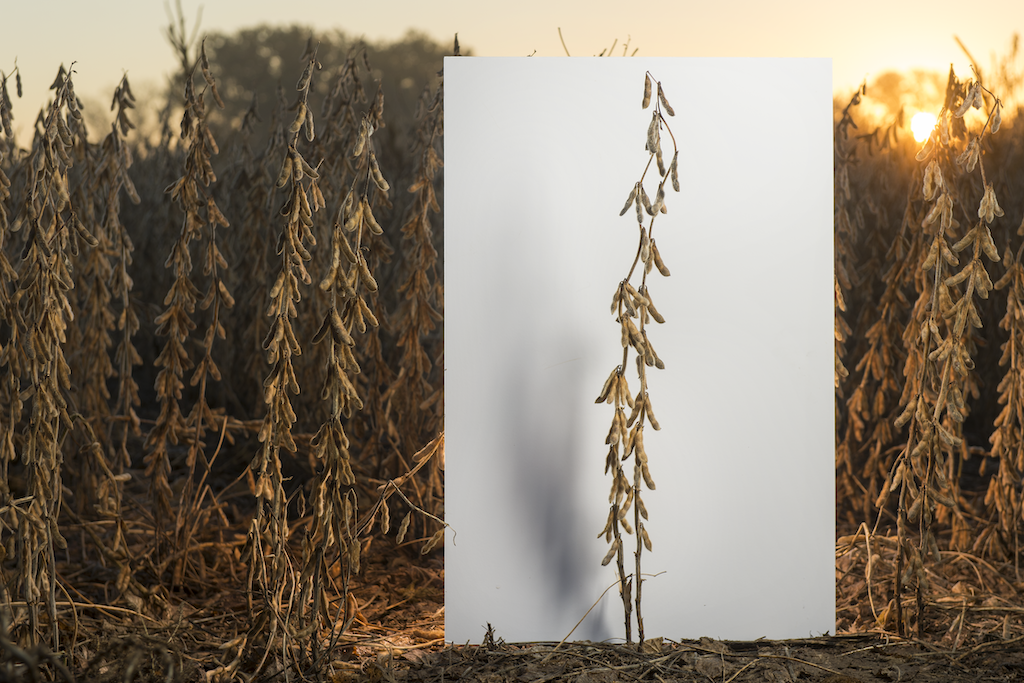
John Hertlein and his 48-year-old son Jim farm about 580 acres, 80% of which are planted with soybeans
Luke Townsend
A small screen in Hertlein’s cab shows live video of the grain tank filling up. Every so often, the tank has to be emptied into a storage container pulled by a semi-truck or tractor. From there, the beans are either moved into storage tanks or taken to a grain elevator or processor to be sold. (Of course, the beans are stored only after they have been weighed, so that farmers know how many beans they harvested for their landlords; the Hertleins have had as many as 12 different landlords in a year.)
Most, if not all, Emporia farmers will take their soybeans to Bunge Oilseed Processing, the local outpost of the international soybean exporter and agribusiness company Bunge Limited—the largest soybean processing company in the U.S.—because that’s where they’ll get the best price for their beans. Farmers farther away from Emporia are more likely to sell their beans for a lower price to a local grain elevator, because the cost of transporting beans to Bunge might not be worth the higher price they could get per bushel. But many of those grain elevators will eventually sell their beans to Bunge, too.
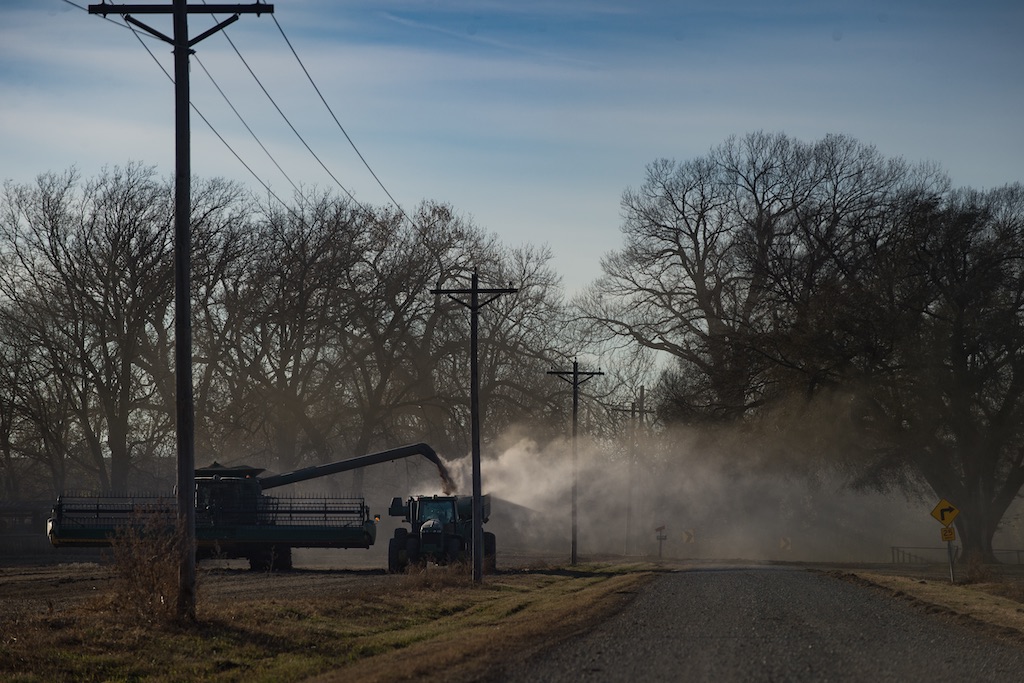
Harvested soybeans are poured into a storage container, before they get sent for processing
Luke Townsend
Bunge Limited declined to comment for this story, but industrial soybean processing practices are pretty similar. After the beans are unloaded from the truck they are cleaned and stored. When it comes time for processing, they are further cleaned and run through a dryer to lower the moisture content. Then they are cracked into pieces and the hulls are removed, to be sold as cattle feed. The remaining bits of soybean are put through a steamer, so they are softer and more pliable, and then rolled into flakes.
Oil is extracted from the flakes with hexane solvent. Then the hexane solvent must be removed from the oil-solvent mixture, or miscella, with steam, condensed, and then reused. The flakes are cleaned of the solvent, dried, and ground into meal for animal feed. “Mineral scrubbers” remove any remaining hexane from the oil and it is either shipped as crude soybean oil, or refined for food or industrial use, which involves removing certain proteins, fatty acids, and gums. Bunge Oilseed Processing in Emporia has its own rail spur, so the company can fill tank cars with oil on site and then send them out by train. Bunge also ships meal and oil out by truck.
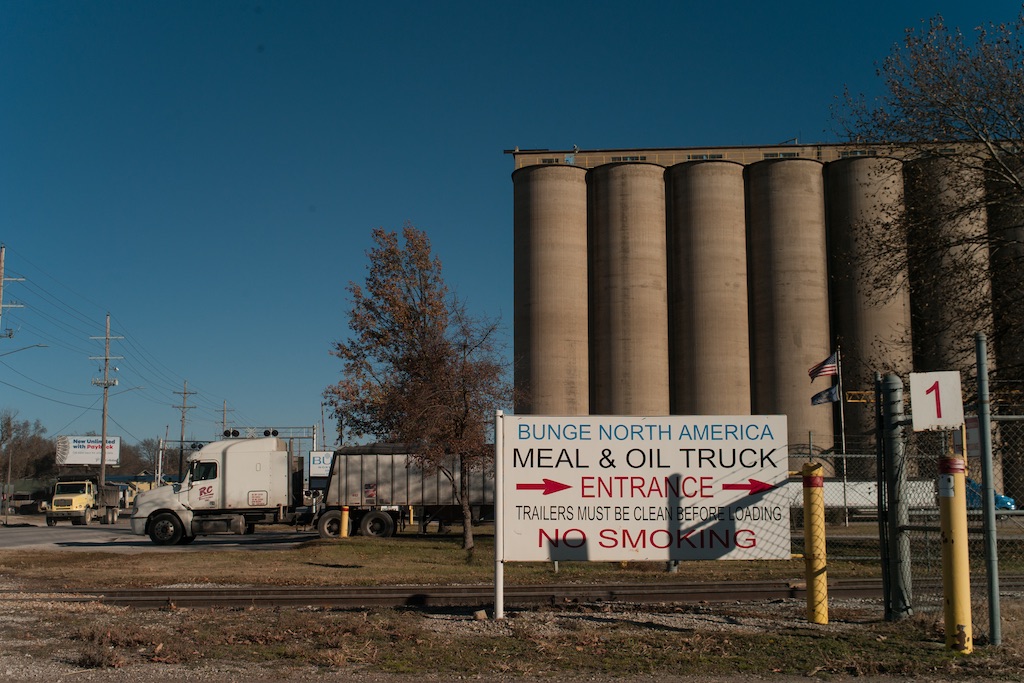
Beans brought to Bunge Oilseed Processing are cleaned, stored, and later rolled into flakes, from which oil is then extracted
Luke Townsend
The vast majority of soybeans cultivated in the U.S. are destined for a fate very similar to those grown in the field next to my house. Whether they end up in cattle feed or biodiesel or plastics or vegetable oil is all very much a matter of chance. But there are other ways to do it.
Alt-farming
Darin Williams, age 46, is not your average Kansas farmer.
Although Williams helped his father farm in high school, it was never the family’s primary source of income; his father also worked as a financial consultant. Williams assumed he would never be able to make a living on farming alone, so he went into trade as a carpenter and contractor in the Kansas City area. About eight years ago, after moving back to Waverly, Kansas, to work with his father on the farm, he learned about no-till farming and cover crops—regenerative agricultural practices that proponents say lower input costs and increase yields. Seeing a chance to actually turn a decent profit, Williams persuaded his father to let him try out that method of farming on some of their land, and after a few years he says his father was completely won over.
On a cold November morning, Williams drives me out in his truck to visit some of his soybean fields, and to demonstrate how smooth, uniform, and free of weeds his fields are, even when compared to his neighbors’ fields, which have been heavily treated with herbicides. It was only after he figured out how to do weed control with no-till and cover cropping that Williams was able to experiment with non-GMO beans.
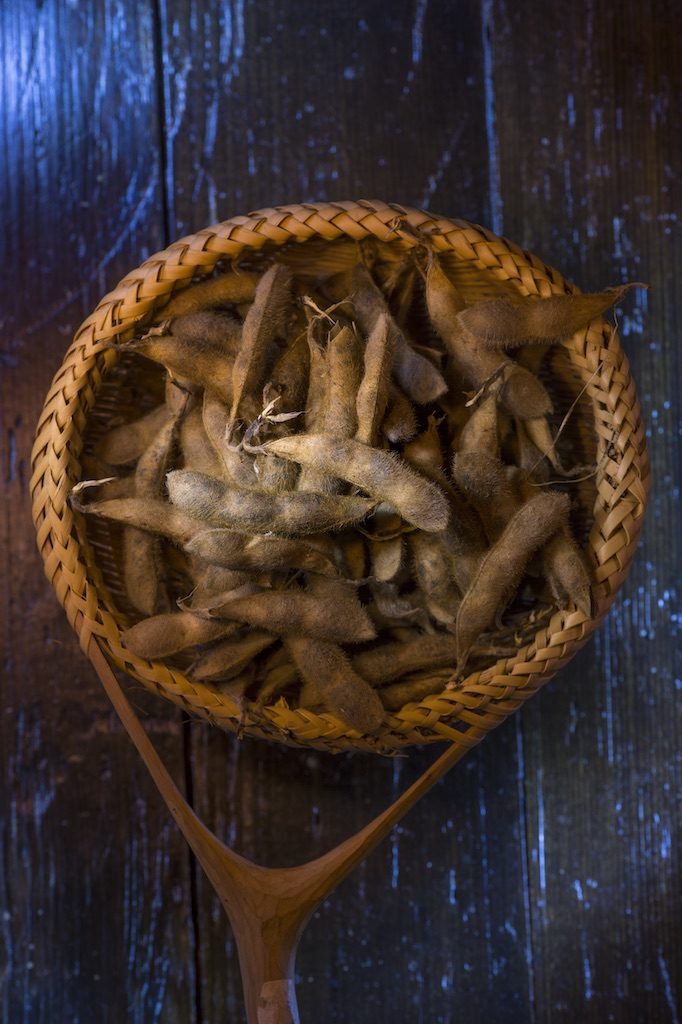
Luke Townsend
Neither Hertlein nor Williams has received any money from the tariff relief program yet due to delays in their respective harvests linked to poor weather conditions
“I was more curious than anything whether the older varieties could still yield as good as some of the new varieties in the genetically modified market,” Williams says. He put in some plots of non-GMO soybeans as well as some plots of Roundup Ready and Roundup Ready 2 beans, which have been genetically modified to be resistant to Roundup Ready herbicide.
“The first year we did that we didn’t see hardly any difference in yield,” says Williams. “Certainly not enough difference in yield to warrant the extra money being spent on seed and whatnot.” Williams continued to experiment with different varieties to see which worked best on his land.
Tackling the world of non-GMO soybeans opened up a number of new markets in Europe and Asia, where non-GMO beans fetch a premium. To capitalize on the opportunity, Williams started a non-GMO distribution company that sells to both growers and buyers of non-GMO crops, providing seeds to the former and product to the latter.
Williams now grows six varieties of non-GMO soybeans: the Kansas State soybean 5518; the Williams 82; the Hutchinson soybean; the 9956 Willcross; the clear hilum; and the buff hilum. Two of those, the Williams 82 and the Hutchinson, are beans in the public domain, meaning Williams can clean and store and reuse the beans as seeds without paying the license-holder a fee.
Williams tries to market his soybeans as close to the end-user as possible, so that middlemen don’t cut into his profits as much. As such, most of his soybeans will take a drastically different route to market than the ones grown in the field next to my house. For example: one variety of bean grown specifically for tofu will be harvested and taken to Williams’ own distribution facility to be cleaned and conditioned before being loaded into a shipping container, driven to a port, and shipped to Taiwan.
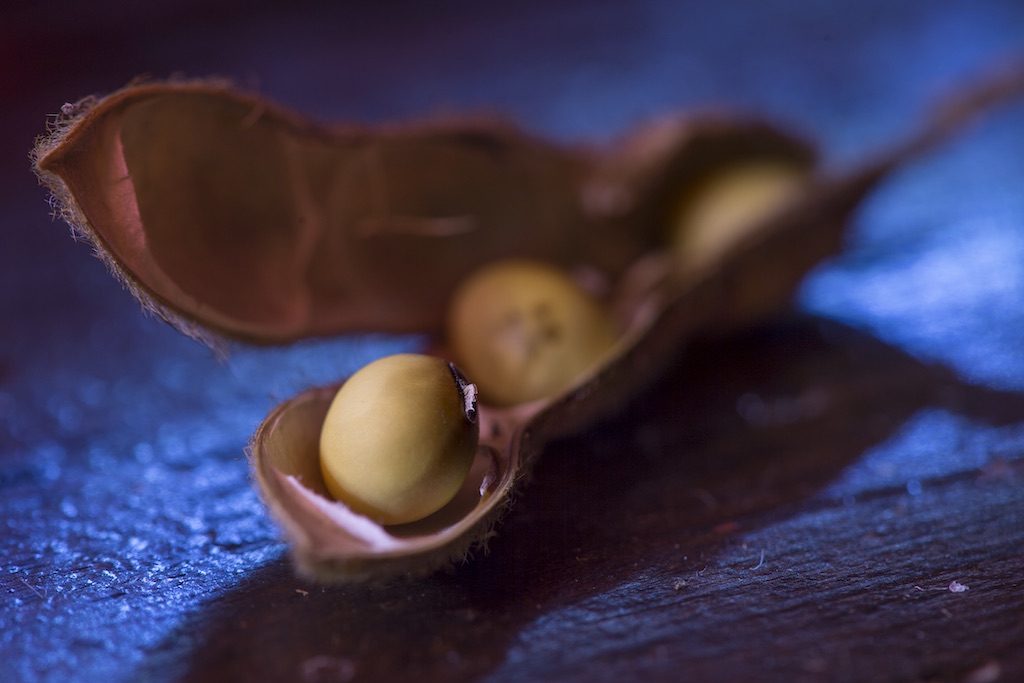
The USDA has forecasted soybean acreage in the U.S. will drop by 6.6 million acres in 2019 as farmers opt to grow other crops
Luke Townsend
But even Williams, doing his best to work outside the commodity market, is susceptible to the tremors resulting from tensions between China and the U.S. Although he has a guaranteed buyer in Taiwan, Williams is still getting a lower price for his soybeans because the price is set by the futures market.
Williams currently farms around 2,000 acres: 400 acres of corn, 300-400 acres of cereal crops, and soybeans on the remaining acreage. He expects that ratio to stay about the same next year. When I ask why he won’t cut down on soybeans in response to the trade war and grow more of something else, like corn, he tells me that corn is just too difficult to make a profit on. The costs of planting are higher and the returns are lower, at least in this part of Kansas. Williams knows his best bet for making a living is still in soybeans.
Daniel O’Brien, an agricultural economist at Kansas State University, follows the grain markets and shares what he learns with farmers at public meetings and other outreach events. He says he is not necessarily advising farmers to do anything differently next year.

Even farmers working outside the commodity market are susceptible to the tremors resulting from tensions between China and the U.S. (Photo credit: Luke Townsend)
Luke Townsend
“Kansas farmers really, well—they’ll decide on their own,” O’Brien says. “As you well know, they’re really a pretty good set of economists. They think very economically and try to maximize profit and do well and survive. They’ll judge the potential profitability for them growing those crops because even if they own that land they’re at least paying taxes, and if they’re buying land or renting it then they have some even higher costs associated with that land. So they have to cover costs unless they want to subsidize [their farming] from other sources of income. They can grow all sorts of crops … but they’ll generally grow something where there’s established markets.”
O’Brien says he wouldn’t be surprised to see some farmers switch to corn “on the margins,” but a lot of it will depend on what South American farmers do. If they replace acreage previously used to grow corn with soybeans, for example, then it might make sense for American farmers to plant more corn. Some experts have said that the changes in the soybean market this year and in 2019 could impact U.S. farmers for years to come. If China diversifies its sources for soybeans, it may never again import as many from the U.S. as it did previously.
Risky business
Hertlein has already sold at least one load of beans to Bunge, but he expects to hold on to the rest of his harvest for a while—something he might have done even if the trade war wasn’t going on, to play the market. “Sometimes you can pick up a dollar [a bushel],” he says, adding with a small laugh: “It’s another way of gambling.”
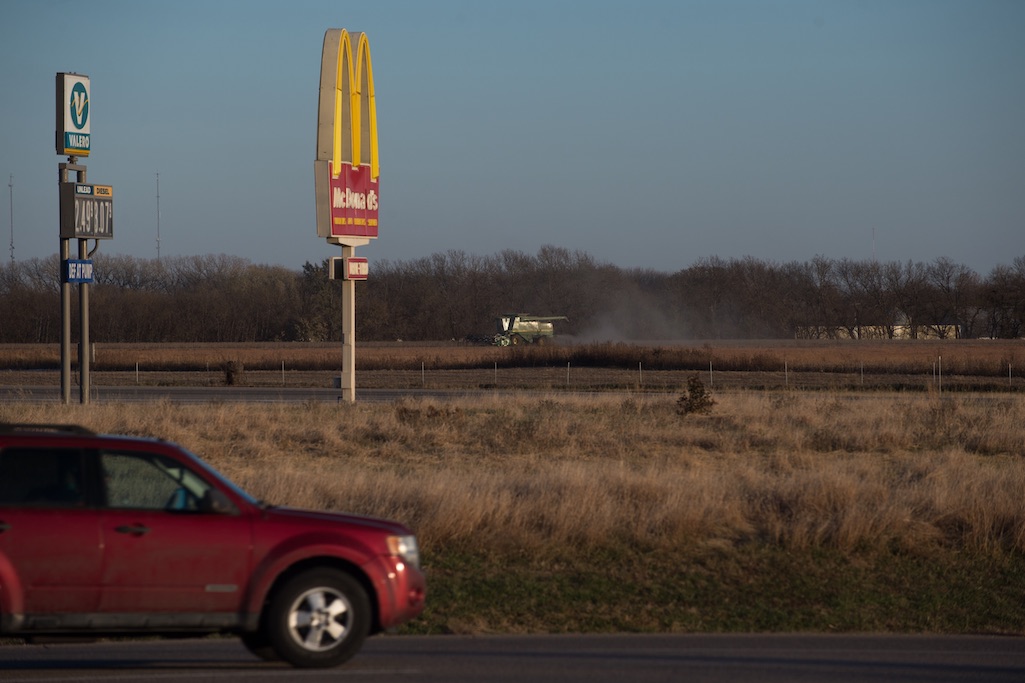
If China diversifies its sources for soybeans, it may never again import as many from the U.S. as it did previously
Luke Townsend
Bunge’s CEO, Soren Schroder, has speculated that any soybean farmer in the country who can store beans will do so, in the hope of getting a better price when the trade war is resolved.
Sitting at his kitchen table with his feet propped up, Hertlein projects an air of indifference, a roll-with-the-punches attitude ingrained in farmer DNA. “The price is going to fluctuate,” he says. “It depends on foreign markets on beans and nobody really knows what exactly is going to happen.”
Meanwhile, the government relief fund for farmers impacted by the trade war is off to a rough start, as The New York Times has reported. Neither Hertlein nor Williams has received any money from the program yet because they cannot apply until harvest is completed, and wet and snowy weather in Kansas forced farmers to push back harvest as they waited for the fields to dry. Hertlein was finally able to finish harvesting the Saturday after Thanksgiving.
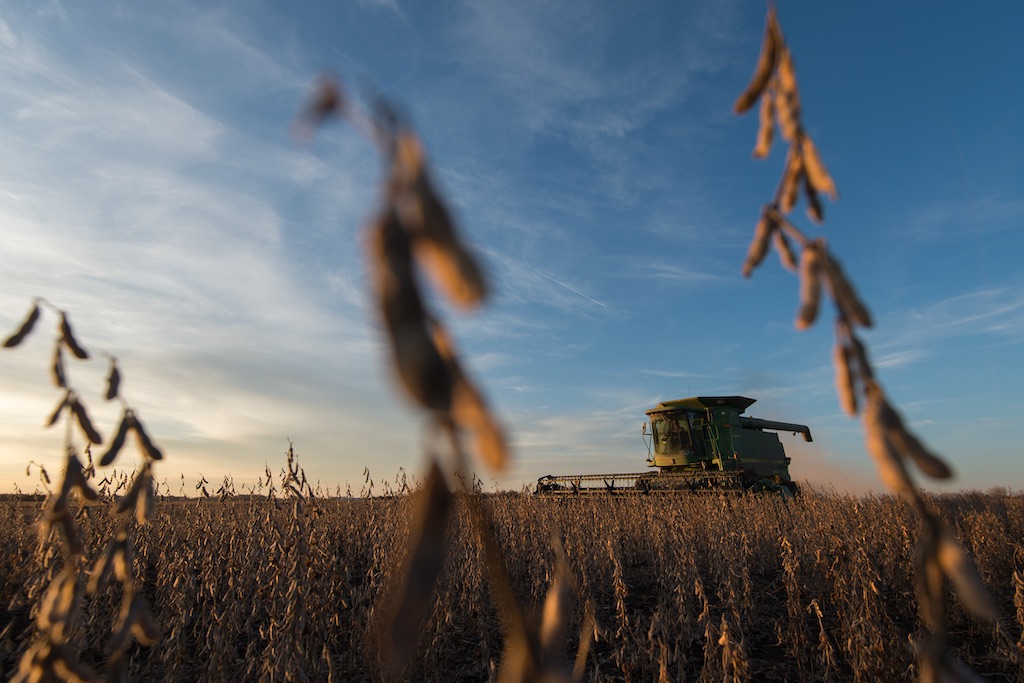
If China diversifies its sources for soybeans, it may never again import as many from the U.S. as it did previously
Luke Townsend
Williams says that if the federal government pays farmers the full $1.65 per bushel that the $12-billion aid program allotted soybean farmers, “there’s no question that that’ll help tide people over.” However, he recognizes that it’s a temporary fix, not a solution.
Williams believes the trade war is a necessary inconvenience, but at the same time says it cannot go on indefinitely. “I hope the thing gets resolved before the end of the year,” he says. “Obviously it cannot drag on for another year. Something is going to have to happen in the next three to four months or things will probably take a turn for the worst.”






